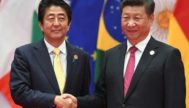Authors
James J. Przystup

Areas of Expertise: Asia-Pacific; Japan, the Korean Peninsula, Southeast Asia
Dr. James J. Przystup has worked on Asia-related issues for over thirty years: on the staff of the United States House of Representatives Subcommittee on Asian and Pacific Affairs; in the private sector with Itochu Corporation and IBM World Trade Americas/Far East Corporation; in the United States Government, on the State Department’s Policy Planning Staff under Secretary of State George P. Shultz and under Secretary of State James A. Baker III, as Senior Member responsible for East Asia and the Pacific; and in the Office of the Under Secretary of Defense for Policy, as Director for Regional Security Strategies on the Policy Planning Staff. During the administration of President Ronald Reagan, Dr. Przystup served as the Deputy Director of the Presidential Advisory Commission on U.S.-Japan Relations. He also served on the State Department delegation to the Paris Peace Conference on Cambodia. Before accepting his current position, he was Director of the Asian Studies Center at the Heritage Foundation. Dr. Przystup was presented with the State Department’s Meritorious Honor award in 1989 and 1991; the Defense Department’s Outstanding Achievement Award in 1992; and cited for his Exceptional Performance by the National Defense University on three separate occasions.
Dr. Przystup graduated summa cum laude from the University of Detroit and holds an M.A. in International Relations from the University of Chicago and a Ph.D. in Diplomatic History also from the University of Chicago. He studied Japanese at Columbia University and Keio University in Tokyo and was a Visiting Fellow on the Law Faculty of Keio University.
Recent Publications:
“The Foreign Policy of Prime Minister Shinzo Abe: Strategic Vision and Policy Implementation,” with Yuki Tatsumi, The Asan Institute for Policy Studies, February, 2015.
“The U.S.-Japan Alliance: Review of the Guidelines for Defense Cooperation,” Center for Strategic Research, Institute for National Strategic Studies, National Defense University, March 2015.
“The Grand Design of the U.S.-Japan Alliance at a New Stage,” Japan Forum on International Relations, June 2015.
“Why We Don’t Need Another Kennan,” with Robert Manning, Nikkei Asian Review, August 6, 2015.
‘U.S.-China: Cooperation and Competition,” East Asia Forum, July-September 2015.
Articles by James J. Przystup

Japan - China
September — December 2016Abe-Xi Met; Diplomats Talked; Wait ‘Til Next Year…
Prime Minister Abe and President Xi met twice in the last four months of 2016. Both committed to advancing the relationship during 2017, taking advantage of the opportunities presented by historic anniversaries – the 45th anniversary of normalization and the 40th anniversary of the Japan-China Friendship Treaty. Both leaders also committed to the early implementation of an air and maritime communications mechanism. Notwithstanding the increasing air and maritime interactions between the PLA and the Japanese SDF and Coast Guard, working-level officials were unable to reach agreement. At the end of the year, the Abe government announced a record high defense budget for 2017; days later the China’s aircraft carrier transited in international waters between Okinawa and Miyakojima into the western Pacific. Meanwhile public opinion polling revealed growing pessimism in Japan with respect to China and Japan-China relations.
Japan - China
May — August 2016No Lack of Dialogue, Results – TBD
There was no lack of high-level bilateral dialogue over the summer months with the foreign ministers meeting three times between late April and the end of August. There were several other exchanges in between including a meeting between Prime Minister Abe and Premier Li in July at the Asia-Europe Meeting in Ulaanbaatar. Despite the dialogue, strong differences continued to mark the relationship, in particular on issues related to the South China Sea and the East China Sea. Tensions heightened in June when a PLA Navy ship entered Japan’s territorial waters off Kagoshima and again in August when Chinese fishing boats and Coast Guard ships swarmed into the Senkakus, entering Japan’s contiguous zone and territorial waters despite repeated high-level protests.
Japan - China
January — April 2016Staying on a Test Course
Citing his November meeting with Premier Li as evidence, Prime Minister Abe found relations with China improving in his Diplomatic Report to the Diet. Chinese officials took a more cautious view. While acknowledging progress, China’s ambassador to Japan called attention to unstable elements in the relationship and Foreign Minister Wang Yi accused Japan of “double dealing” in its relations with China. Issues related to the East China Sea and the South China Sea continued to trouble the relationship. Chinese Coast Guard ships made incursions into Japan’s territorial waters in the Senkakus while Japan continued to strengthen its military presence in Okinawa and the southwest islands. The foreign ministers met at the end of April.
Japan - China
September — December 2015Moving in the Right Direction
Senior political and diplomatic contacts expanded in late 2015. Prime Minister Abe met Premier Li in October and President Xi briefly in November. Meanwhile, maritime issues dominated the policy agenda: China’s natural gas exploration in the East China Sea, incursions into Japan’s territorial waters near the Senkaku/Diaoyu Islands, and China’s land reclamation projects in the South China Sea. History issues also punctuated the period – the September victory parade in Beijing, at UNESCO, and the anniversary of the Nanjing Massacre in December. Nevertheless, there was a general sense that relations were moving in the right direction.
Japan - China
May — August 2015To August 15 – Toward September 3
The summer months witnessed a parade of senior Liberal Democratic Party figures traveling to Beijing. The visits were aimed at sustaining positive political trends, securing an invitation for Abe to visit China, and anticipating issues related to Abe’s August statement commemorating the end of World War II. Meanwhile, China prepared to celebrate the 70th anniversary of the Chinese People’s War of Resistance against Japanese Aggression and the World Anti-Fascist War with a victory parade on Sept. 3. Against this backdrop, each country sought to enhance its security posture in the East China Sea and South China Sea, further besetting bilateral relations.
Japan - China
January — April 2015Gaining Traction
Despite ongoing discussions of history and present-day issues related to the Senkaku/Diaoyu Islands, there was a general sense in both Tokyo and Beijing that relations were slowly moving in the right direction. Meetings took place between senior diplomats and political leaders. Slowly gaining traction, engagement culminated in the April 22 Xi-Abe meeting in Bandung, Indonesia, featuring smiles, handshakes, and a 25-minute talk – a far different picture of the relationship than that presented at the November meeting in Beijing. However, Xi and other Chinese officials consistently made it clear that progress in restoring relations would depend significantly on Japan’s proper understanding of history, in particular Prime Minster Abe’s much anticipated statement commemorating the 70th anniversary of the end of the war.
Japan - China
September — December 2014A Handshake at the Summit
Prime Minister Abe realized his long quest for a summit with President Xi during the APEC meeting in Beijing. The picture of the encounter – Xi’s averted gaze at the handshake – spoke volumes, underscoring the politically sensitive issues that trouble the relationship: disputed history, Yasukuni, and the Senkaku/Diaoyu Islands. China commemorated several anniversaries: the victory over Japan on Sept. 3, the Mukden Incident on Sept. 18, and the Nanjing massacre on Dec. 13. In the East China Sea, Chinese Coast Guard ships regularly operated in Japan’s contiguous zone, while asserting administrative jurisdiction and frequently entering Japan’s territorial waters. Meanwhile, Chinese fishing boats engaged in coral poaching within Japan’s EEZ. Polls in both countries revealed a continuation of mutually strong negative feelings.
Japan - China
May — August 2014Searching for a Summit
Japan spent the summer months pressing for a summit. In remarks to the Diet, press conferences, and public speeches Prime Minister Abe made clear his quest for a summit with President Xi during the November APEC meeting in Beijing. A parade of Japanese political figures explored the possibility of a summit during visits to China. Beijing continued to point to the obstacles – Abe’s visit to Yasukuni Shrine and Japan’s failure to recognize the existence of a dispute over the Diaoyu/Senkaku Islands. Meanwhile, incursions by China’s Coast Guard into Japan’s territorial waters continued and two mid-air incidents heightened security concerns. Japanese investment in China plunged over 40 percent in the first half of the year, and history remained ever present.
Japan - China
January — April 2014Past as Prologue
History dominated the Japan-China relationship. Controversies over the Yasukuni Shrine, the Senkaku/Diaoyu Islands, Ahn Jung-geun, the Kono and Murayama Statements, Nanjing, compensation for wartime forced labor, and China’s seizure of a Mitsui ship over a wartime-related contract dispute marked the first four months, ending almost where the year began with Prime Minister Abe making an offering to the Yasukuni Shrine during the spring festival. Meanwhile, Chinese Coast Guard ships operated on an almost daily basis in the Senkakus, occasionally entering Japanese territorial waters. In response, Japan increased the presence of the Self-Defense Forces in the southwest islands.
Japan - China
September — December 2013Can We Talk?
China marked the first anniversary of Japan’s nationalization of the Senkaku Islands by reasserting its sovereignty claims to the islands and conducting Coast Guard patrols in the area, which continued on a regular basis through December. Tokyo called for dialogue with China without preconditions, while Beijing insisted that dialogue required Japan to admit the existence of a dispute over the islands. Meanwhile, business leaders continued to develop economic ties and Japanese companies in China began to recover from the profit doldrums that followed initial Chinese reaction to the nationalization. In late November, Beijing announced the establishment of its East China Sea ADIZ, which Tokyo found to be unacceptable and refused to recognize. Prime Minister Abe added more tension to the relationship when he visited Yasukuni Shrine.